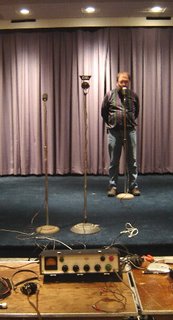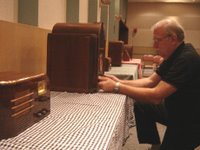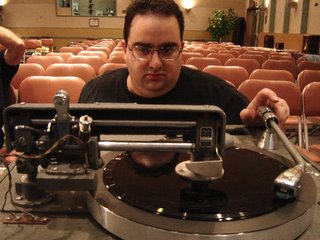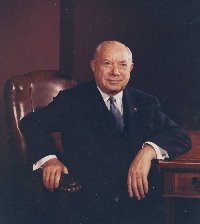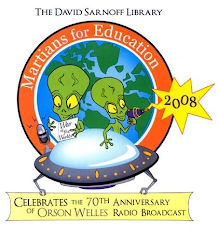DAVID SARNOFF LIBRARY TO HOST LIVE “WAR OF THE WORLDS" RADIO THEATRE
Full-Scale Performances Will Mark the 68th Anniversary of Welles’s Radio Broadcast
GROVER’S MILL, NJ: October 11, 2006—Returning to one of the most famous events in American radio, the David Sarnoff Library, in cooperation with the Hunterdon Radio Theatre and New Jersey Antique Radio Club, reprises its live re-enactment of Orson Welles’s 68-year-old broadcast, “War of the Worlds,” based on H.G. Wells’s classic story. This family-friendly event, which will benefit the Library’s renovation, is scheduled for Saturday, October 28, in Sarnoff Corporation’s auditorium in Princeton Junction, N.J.; there will be matinee and evening performances, with a special benefit reception after the evening show.
On October 30, 1938, Orson Welles and his Mercury Theater On the Air captivated the nation and set off widespread panic—especially in New Jersey and New York—with a dramatization of H.G. Wells’s 19th-century fantasy. Thousands of listeners across the country mistook the broadcast for news reports of an actual Martian invasion that detailed meteor landings in nearby Grover’s Mill, N.J., and aliens killing earthlings with death-rays. What resulted was mass hysteria, with residents fleeing their homes or joining to combat the “Martians.”
“David Sarnoff predicted and innovated the power of network broadcasting,” says Dr. Alex Magoun, executive director of the David Sarnoff Library. “Welles’s broadcast showed how the media could instantly encourage national hysteria as well as national unity. We think that’s a powerful lesson worth revisiting. Moreover, the Princeton Observatory and Grover’s Mill, where the Martian launches and landing were reported, are only a mile away from us, at Princeton University and in West Windsor Township.”
The “War of the Worlds” broadcast, which was written by Howard Koch and made famous by Welles is “arguably one of the best radio dramas of all time,” says William Spear, founder and president of the Hunterdon Radio Theatre. The group, which will stage the re-enactment with more than 20 actors, is “excited about the opportunity to work with the David Sarnoff Library and present its version of the broadcast.”
The sound effects and actors’ voices will be transmitted through 1930s microphones to 1930s radios, provided by members of the New Jersey Antique Radio Club. “Listening to radio theatre is an experience unlike anything two generations raised on television and the internet have ever felt,” says NJARC president Phil Vourtsis. “And to listen to the sounds of a Martian invasion through the radios of the time makes you appreciate how much the world has changed since the original broadcast.”
Performances will begin at 2:00 p.m. and 7:30 p.m. The doors will open one hour prior to the shows, allowing visitors to tour the Library’s new exhibits on David Sarnoff and the Innovative Spirit and Six Innovations that Changed the World. All tickets for the matinee performance are $10 in advance ($15 at the door).
Ticket prices for the evening performance, which will be followed by a dessert reception sponsored by Grover's Mill Coffee Company, are as follows: adults 13-64 are $20 in advance ($25 at the door); all others are $10 in advance ($15 at the door). Chanteuse Samantha Chapman and the Red Planet Radio trio will perform period songs during the reception and in the lobby before the show. Tickets are limited and advance reservations are strongly recommended.
All funds raised from this event will support the David Sarnoff Library, a 501(c)(3) nonprofit organization housed within Sarnoff Corporation at 201 Washington Road, Princeton. The Library contains a museum and archives with the state’s largest holdings of RCA historical materials, and is dedicated to the understanding and promotion of electronic innovation for the benefit of humanity. The Library is open by appointment for tours and field trips. For more information, visit davidsarnoff.org on the Web.
The “War of the Worlds” re-enactment is made possible, in part, by the kind support of Sarnoff Corporation; the Howard Koch Estate; Hunterdon Radio Theatre; New Jersey Antique Radio Club; Grover’s Mill Coffee Company; and suite6design.
Additional assistance and funding has been provided by the Board of Directors of the David Sarnoff Collection and an operating support grant from the New Jersey Historical Commission, a division of the Department of State.
To pay for advance tickets, visit Paypal and direct payments to sales@davidsarnoff.org. Or, send a check to the David Sarnoff Library, CN5300, Princeton NJ 08543-5300, specifying the show and number and type of tickets.
For more information about the event or advance ticket reservations, send an email to waroftheworlds@davidsarnoff.org, or call (215) 885-2195 or 866-204-5798, pin# 7988 (toll free).
Tuesday, October 10, 2006
Wednesday, September 13, 2006
Invention of LCDs: IEEE Milestone Event
The IEEE Princeton/Central Jersey Section,
along with
Dr. Michael Lightner, Sarnoff Corporation,
and the David Sarnoff Library
Cordially Invite You to
The Dedication of the IEEE Milestone
for the Invention of
Liquid Crystal Displays
Between 1964 and 1968, a team of engineers and scientists led by George Heilmeier with Louis Zanoni and Lucian Barton at RCA's David Sarnoff Research Center devised a method for the electronic control of light reflected from liquid crystals. Their demonstration of the world's first LCDs launched a global industry that produces millions of displays annually for watches, calculators, instruments, telephones, televisions, and computers.
Saturday, September 30, 2006
Sarnoff Corporation Auditorium
201 Washington Road Princeton NJ 08540
David Sarnoff Library Open House with NJARC repair clinic, demos, and exhibits: 10 am – 4 pm
Reception: 4:00 - 5:00 pm
Ceremony 5:00 - 6:30 pm
The IEEE Milestone program honors significant achievements in electrical, electronic, and computer engineering. The Milestones are intended to increase public understanding of these forms of engineering; increase community appreciation for engineers; foster pride among engineers of their history; stimulate documentation of significant events and preservation of historic sites; and make the information widely available. Since their inception in 1982, over 70 Milestones have been dedicated around the world.
Please also join Sarnoff Corporation and many others as a sponsor in the program book, which will be distributed at the ceremony. For an additional contribution, join Dr. Michael Lightner, president and CEO of the IEEE; Dr. Curt Carlson, vice chairman of Sarnoff Corporation and CEO of SRI International; and the honorees and speakers for a dinner at 7:00 pm.
Platinum sponsors $1000 (Full page, 6 dinner seats)
Gold sponsors $500 (Half page, 4 dinner seats)
Silver sponsors $250 (Quarter page, 2 dinner seats)
Bronze sponsors $100 (Business card)
Name sponsor $25
Please make out checks to the “IEEE Princeton/Central Jersey Section” and send to
Wieslaw Bury, Ph.D.
Electronics Department
630 US Hwy One
North Brunswick NJ 08902-3362
Please send digital print-ready art to info@davidsarnoff.org
Questions? Contact Dr. Alexander Magoun at amagoun@davidsarnoff.org or 609-734-2636
Questions? Contact Dr. Alexander Magoun at amagoun@davidsarnoff.org or 609-734-2636
Monday, July 31, 2006
Italian Students Visit the Library
Thanks to a tip by Louis Zanoni of WZBN, executive director Alex Magoun contacted Dr. Chiara Nappi of Princeton University's Physics Department to invite her summer course visitors to visit the Library. They appeared, all 46 including chaperones, on Friday afternoon, July 28. Alex led them on a tour of Mr. Sarnoff's office and exhibits, during which they learned about his origins, his motivation, and his strategies for improving the world's ability to exchange information. Alex also explained how industrial physicists, chemists, and engineers manipulated electrons, light, and phosphors, in vacuum and then in solids, in order to accomplish Sarnoff's goals.
Here are two photos, courtesy of Mr. Zanoni, of the tour and the group:


Here are two photos, courtesy of Mr. Zanoni, of the tour and the group:


Lectures, Exhibits Attract Great Crowds
Over 220 people attended the three lectures on Thomas Edison, Bell Laboratories, and David Sarnoff last month in Sarnoff Corporation's Auditorium. Besides engaging with the speakers--Drs. Paul Israel, Sheldon Hochheiser, and Alexander Magoun--they also took in the new exhibits on David Sarnoff and the Innovative Spirit and Six Innovations that Changed the World. The lectures and exhibits were made possible in part by a project grant from the New Jersey Council for the Humanities, an operating support grant from the New Jersey Historical Commission, and the support of Mr. Arthur Sarnoff.
Here's Dr. Hochheiser on-stage, and one of the slides highlighting Claude Shannon and information theory as one of Bell Labs' signal contributions to the world in which we live:
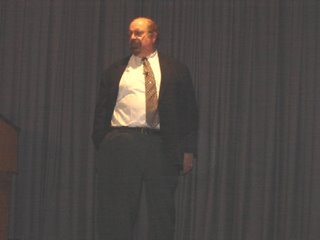
Here's the audience for Sheldon Hochheiser's lecture on Looking Down from Murray Hill: Six Innovations that Changed the World, on Tuesday, June 13:
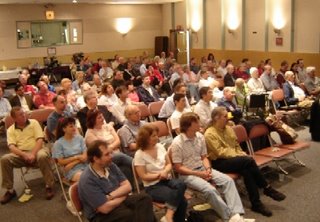
Videographer Dave Sica of Sica Productions generously donated his time and skills to filming the lecture. Thanks to him and the equally generous Dave Hall of Davideo Multimedia, the three lectures will be made available on-line; for now, you can watch Dr. Hochheiser on Google Video here!
The exhibits involved renovating the artifact displays and mounting posters prepared by Alex Magoun, Sam Missimer of Venezia Associates, and Maria Mattera of Suite6 Design. On Saturday, May 20, Alex called on the strong backs of the New Jersey Antique Radio Club to remove the glass covers from the three main cases in the Library. In five hours he rearranged the exhibits to highlight Sarnoff's early career, video cameras, semiconductors, and computers.
On Memorial Day, Louise Grafton recovered the plinths in the five vertical cabinets with black, white, red, green, and blue fabric before Alex rearranged some of the contents. In particular, you can now see the first color TV picture tube and a signed baseball from the first night game broadcast in color between the Cincinnati Reds and the New York Giants on May 16, 1960 (the Reds won at Crosley Field, 9-2)
Finally, with the arrival of the posters portraying David Sarnoff's innovative spirit, carpenters Charlie Brzezynski and Bob Sanders of Sarnoff Corporation's Facilities crew installed mountings on the Library's columns to which the posters could be attached with velcro. Volunteer Phil Vourtsis helped fasten them on the level.
Our thanks to all above as well as Sarnoff Corporation's Lou Ann Wingerter for consulting on poster placement; Scott Marshall of Fedex Kinko's for sterling work in producing labels and mini-posters; and to Sharon Chapman for supervising refreshments and encouraging so many of the audience to fill out the NJCH's surveys after each lecture!
Here's Dr. Hochheiser on-stage, and one of the slides highlighting Claude Shannon and information theory as one of Bell Labs' signal contributions to the world in which we live:

Here's the audience for Sheldon Hochheiser's lecture on Looking Down from Murray Hill: Six Innovations that Changed the World, on Tuesday, June 13:

Videographer Dave Sica of Sica Productions generously donated his time and skills to filming the lecture. Thanks to him and the equally generous Dave Hall of Davideo Multimedia, the three lectures will be made available on-line; for now, you can watch Dr. Hochheiser on Google Video here!
The exhibits involved renovating the artifact displays and mounting posters prepared by Alex Magoun, Sam Missimer of Venezia Associates, and Maria Mattera of Suite6 Design. On Saturday, May 20, Alex called on the strong backs of the New Jersey Antique Radio Club to remove the glass covers from the three main cases in the Library. In five hours he rearranged the exhibits to highlight Sarnoff's early career, video cameras, semiconductors, and computers.
On Memorial Day, Louise Grafton recovered the plinths in the five vertical cabinets with black, white, red, green, and blue fabric before Alex rearranged some of the contents. In particular, you can now see the first color TV picture tube and a signed baseball from the first night game broadcast in color between the Cincinnati Reds and the New York Giants on May 16, 1960 (the Reds won at Crosley Field, 9-2)
Finally, with the arrival of the posters portraying David Sarnoff's innovative spirit, carpenters Charlie Brzezynski and Bob Sanders of Sarnoff Corporation's Facilities crew installed mountings on the Library's columns to which the posters could be attached with velcro. Volunteer Phil Vourtsis helped fasten them on the level.
Our thanks to all above as well as Sarnoff Corporation's Lou Ann Wingerter for consulting on poster placement; Scott Marshall of Fedex Kinko's for sterling work in producing labels and mini-posters; and to Sharon Chapman for supervising refreshments and encouraging so many of the audience to fill out the NJCH's surveys after each lecture!
Thursday, May 11, 2006
Library Marks Sarnoff’s Centenary with Lectures, Exhibits
 One hundred years ago, a fifteen-year-old immigrant started work as an office boy for the Marconi Wireless Telegraph Company of America, and the world changed because of it.
One hundred years ago, a fifteen-year-old immigrant started work as an office boy for the Marconi Wireless Telegraph Company of America, and the world changed because of it. This June, the David Sarnoff Library will honor its namesake with three illustrated lectures and two exhibits on Sarnoff’s career and New Jersey innovations that changed the world. The lectures take place in Sarnoff Corporation’s Auditorium on successive Tuesday evenings on the 6th, 13th, and 20th of June, at 7:30 pm. These programs are made possible by grants from the New Jersey Council for the Humanities, a state partner of the National Endowment for the Humanities, and Sarnoff Corporation.
On June 6, Dr. Paul Israel, director of the Edison Papers at Rutgers University, will speak on “Looking Forward from Edison to RCA: Industrial Innovation in Central New Jersey.” He will discuss the geographic, economic, and human aspects that made the Garden State such an attractive location for the world’s greatest inventor and his research and development activities in the late 19th and early 20th centuries.
On June 13th, Dr. Sheldon Hochheiser, former historian and chief archivist for AT&T, will speak on “Looking Down from Murray Hill: Six Innovations that Changed the World.” He will explain why AT&T moved Bell Laboratories across the Hudson River from Manhattan, and discuss some of the innovations that emerged from them, from the transistor to satellite communications to digital networks.
On June 20th, Dr. Alexander Magoun, executive director of the David Sarnoff Library, will speak on “David Sarnoff, RCA, and the Arc of the American Century.” He will trace how Sarnoff’s career parallels the rise and relative decline of his adopted country, from his arrival from Russia in 1900 to the demise of the company he defined, RCA, in 1986.
“David Sarnoff is an icon of the American Dream,” says Dr. Magoun. “He’s Horatio Alger come to life, only we know that he accomplished far more than any of Alger’s children. The lectures and exhibits offer some context for why and how he and RCA’s staff accomplished so much.”
David Sarnoff rose through the ranks of Marconi and its successor, the Radio Corporation of America (RCA), and championed the innovation of electronic technologies to fill the human need for communications, from broadcast radio to color television to technologies enabling the Internet. In the summer of 1941, he helped break ground for what became the David Sarnoff Research Center at the junction of Routes 1 and 571 in Princeton. There, RCA’s scientists and engineers realized Sarnoff’s vision for more compact and convenient communications and information technologies by inventing and innovating color television, liquid-crystal displays, video cameras, low-power and high-frequency transistors, computers and memory technologies, and electron microscopy. Dedicated to improving opportunities through the innovation of electronic communications, Sarnoff and the inventors of RCA made possible a world connected and informed by electronics.
 The exhibits—David Sarnoff and the Innovative Spirit and Six Innovations that Changed the World—visitors opportunities to understand and appreciate the electronic technologies that make modern life possible, and the people who brought them to life. Designed and produced by Venezia & Associates and Suite 6 Designs, they will remain on display for the rest of the year.
The exhibits—David Sarnoff and the Innovative Spirit and Six Innovations that Changed the World—visitors opportunities to understand and appreciate the electronic technologies that make modern life possible, and the people who brought them to life. Designed and produced by Venezia & Associates and Suite 6 Designs, they will remain on display for the rest of the year.The Library will be open before and after the lectures to tour the exhibits. ADA access is available to the lectures. Refreshments will be served. For more information call (609) 734-2636 or email questions@davidsarnoff.org.
Tuesday, January 17, 2006
Digital Computing for Kids of All Ages, January 28
On, Off, AND, OR, NOT: That’s what computers are made of, according to Joyce Weisbecker. And she should know, both as a retired computer scientistand electronics engineer for Lockheed Martin and as the daughter of Joe Weisbecker, the inventor of RCA’s first personal computer in 1972. On Saturday, January 28, at 11 a.m. and 2 p.m. Ms. Weisbecker will explain the theory and practice of digital computing to children of all ages during the David Sarnoff Library’s openhouse and radio repair clinic.
“Personally, I like math,” she says, “but I know many people who don’t. If you can count to one, however, you know enough math for this talk. And if you can follow the logic of switching between AND, OR, and NOT, you can start building your own computer.” Co-sponsored by the New Jersey Antique Radio Club (NJARC), the open house will take place from 10 a.m. to 4 p.m. in Sarnoff Corporation’s auditorium and at the David Sarnoff Library, 201 Washington Road, Princeton, NJ.
The open house also features many other activities. The NJARC’s members don’t repair old computers—yet—but if you want your family heirloom radio repaired,the Radio Club offers a free clinic. Call (609) 734-2636 or email info@davidsarnoff.org with the brand and model number to make an appointment on the hour forone-on-one attention. Many vacuum-tube radios can be fixed in less than 60 minutes, and the Club’s experts will do it for free.
One hundred years ago, fifteen-year-old David Sarnoff began working as an office boy for the Marconi Wireless Telegraph Company of America. That same year,1906, Lee De Forest invented the vacuum-tube amplifier. The rest of the electronic century is history, and the Library’s executive director, Dr. Alex Magoun, will give a talk on David Sarnoff and the Innovative Spirit at 1 p.m. "David Sarnoff personifies the possibilities of the American Dream, from Hester Street to high technology," says Dr. Magoun. "There are few more inspiring stories than that of an immigrant who takes advantage of our freedoms of opportunity and expression toimprove himself and lead others in the creation of new technologies and industries that add to those freedoms."
And if you haven’t heard how good a theremin can sound in the hands of a master, come hear and see Kip Rosser play and explain the first electronic musical instrument in the Library’s museum. “Everyone says the theremin is incredibly difficult to play,” says Rosser. “Well, so’s the violin. If you have an ear and youpractice, you will improve.” Mr. Rosser plays a variety of jazz and pop from the last sixty years of the 20th century, and Dante Bucci will join him for some theremin duets from 10 a.m. to 1 p.m. and 2 to 4 p.m.
The Library’s exhibits offer opportunities for families to compare a century of home consumer media from Graphonolas to Aeriolas to televisions to Ipods. “Every generation has its own way of entertaining and educating itself with sight and sound,” says Dr. Magoun. “Introducing your children to these earlier formats is a greatway of connecting across generations.” The exhibits include a display on the 45-rpm record and player, the first transistor radio and television, a working 1948 television with camera, and a 1981 RCA VideoDisc player connected to a rare working model of RCA’s first color set, built in 1954. Remotes are not included.
The programs and museum are free admission although a suggested donation of five dollars per person is welcome.
The David Sarnoff Library is located at 201 Washington Road, east of Route 1, or at the end of Fisher Place off Route 1, just north of the Washington Road trafficcircle. For more information call 609-734-2636, or check the website at www.davidsarnoff.org/directions.htm. This event is made possible in part by an operating support grant from the New Jersey Historical Commission, a division of the Department of State; and the Friends of the David Sarnoff Library.
“Personally, I like math,” she says, “but I know many people who don’t. If you can count to one, however, you know enough math for this talk. And if you can follow the logic of switching between AND, OR, and NOT, you can start building your own computer.” Co-sponsored by the New Jersey Antique Radio Club (NJARC), the open house will take place from 10 a.m. to 4 p.m. in Sarnoff Corporation’s auditorium and at the David Sarnoff Library, 201 Washington Road, Princeton, NJ.
The open house also features many other activities. The NJARC’s members don’t repair old computers—yet—but if you want your family heirloom radio repaired,the Radio Club offers a free clinic. Call (609) 734-2636 or email info@davidsarnoff.org with the brand and model number to make an appointment on the hour forone-on-one attention. Many vacuum-tube radios can be fixed in less than 60 minutes, and the Club’s experts will do it for free.
One hundred years ago, fifteen-year-old David Sarnoff began working as an office boy for the Marconi Wireless Telegraph Company of America. That same year,1906, Lee De Forest invented the vacuum-tube amplifier. The rest of the electronic century is history, and the Library’s executive director, Dr. Alex Magoun, will give a talk on David Sarnoff and the Innovative Spirit at 1 p.m. "David Sarnoff personifies the possibilities of the American Dream, from Hester Street to high technology," says Dr. Magoun. "There are few more inspiring stories than that of an immigrant who takes advantage of our freedoms of opportunity and expression toimprove himself and lead others in the creation of new technologies and industries that add to those freedoms."
And if you haven’t heard how good a theremin can sound in the hands of a master, come hear and see Kip Rosser play and explain the first electronic musical instrument in the Library’s museum. “Everyone says the theremin is incredibly difficult to play,” says Rosser. “Well, so’s the violin. If you have an ear and youpractice, you will improve.” Mr. Rosser plays a variety of jazz and pop from the last sixty years of the 20th century, and Dante Bucci will join him for some theremin duets from 10 a.m. to 1 p.m. and 2 to 4 p.m.
The Library’s exhibits offer opportunities for families to compare a century of home consumer media from Graphonolas to Aeriolas to televisions to Ipods. “Every generation has its own way of entertaining and educating itself with sight and sound,” says Dr. Magoun. “Introducing your children to these earlier formats is a greatway of connecting across generations.” The exhibits include a display on the 45-rpm record and player, the first transistor radio and television, a working 1948 television with camera, and a 1981 RCA VideoDisc player connected to a rare working model of RCA’s first color set, built in 1954. Remotes are not included.
The programs and museum are free admission although a suggested donation of five dollars per person is welcome.
The David Sarnoff Library is located at 201 Washington Road, east of Route 1, or at the end of Fisher Place off Route 1, just north of the Washington Road trafficcircle. For more information call 609-734-2636, or check the website at www.davidsarnoff.org/directions.htm. This event is made possible in part by an operating support grant from the New Jersey Historical Commission, a division of the Department of State; and the Friends of the David Sarnoff Library.
Looking Back at Fall Events III: NJ Historical Commission Honors Magoun

On Saturday, November 19, 2005, the New Jersey Historical Commission held its 28th annual awards ceremony in conjunction with its history conference at the Trenton War Memorial. Among the ten honorees on this occasion was Dr. Alexander B. Magoun, executive director of the David Sarnoff Library. One of four individual honorees, Alex received his Award of Recognition before 150 members of New Jersey's historical community, including Library board member Dr. Robert Bartolini.
The Commission's citation read as follows:
"Alexander Magoun, Princeton, is recognized for his sterling efforts to establish the library as a professionally run archive that documents innovation in science and engineering. It contains the largest collection of RCA materials in the state, documenting David Sarnoff's career and RCA's work in television, electron microscopy, transistors, computers, and video cameras. Mr. Magoun has rehoused this large collection in archivally appropriate containers and developed an array of services that draw on the rich materials within. These include response by email or phone to research inquiries, hosting researchers on subjects related to technology, the establishment of a popular website, the formation of partnerships with other organizations, public events and presentations--such as Hands-On Radio History and the Color Television Golden Anniversary Event, and tours for students and adults. Alexander Magoun holds a B.A. in history from Trinity College in Hartford, an M.A. from the University of East Anglia, and a Ph.D. in history from the University of Maryland."

Alex in action, speaking on a favorite topic before 250 New Jerseyans at the Archives and History Day event at Monmouth County Library on October 15, 2005.
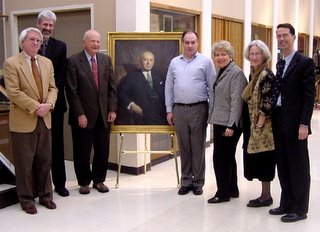
Looking Back at Fall Events II: Great Inventions
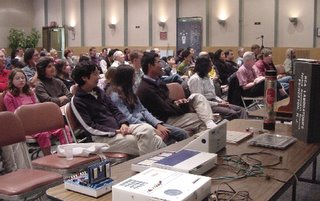
Attracted by the stories of Thomas Edison and RCA Labs as the founders of Route 1's high-tech corridor, over 100 people appeared Saturday, November 12, 2005, for an IEEE family affair on The Great Inventions in Central New Jersey at Sarnoff Corporation's auditorium and the adjoining David Sarnoff Library. They watched, listened, and asked questions as Jack Stanley, director of the Edison Museum at Menlo Park, described and demonstrated some of Thomas Edison's inventions; Dr. David Hochfelder toured the IEEE History Center's online museum and the wonderful store of documents online at the Edison Papers website; and Dr. Alex Magoun, executive director of the David Sarnoff Library, gave an illustrated lecture on "The RCA Origins of Everyday Things."
The Library thanks the Princeton-Central Jersey section of the Institute of Electronic and Electrical Engineers (IEEE). and in particular its chair, Iwan Santoso, for organizing the event--and providing the 30 pizzas for lunch!
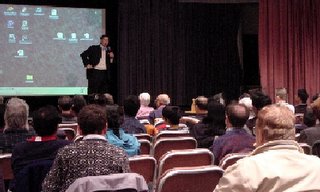
Jack Stanley talks about Edison's aptitude for research as a boy.
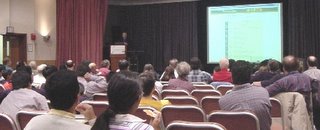
Dr. David Hochfelder explains what a student can find in Thomas Edison's papers.
The Library thanks the Princeton-Central Jersey section of the Institute of Electronic and Electrical Engineers (IEEE). and in particular its chair, Iwan Santoso, for organizing the event--and providing the 30 pizzas for lunch!

Jack Stanley talks about Edison's aptitude for research as a boy.

Dr. David Hochfelder explains what a student can find in Thomas Edison's papers.
Looking Back at Fall Events I: War of the Worlds

Over 160 people of all ages turned out for the David Sarnoff Library's theatrical broadcasts of Howard Koch's and Orson Welles's War of the Worlds on October 29, 2005. Staged by the New Jersey Antique Radio Club and the Hunterdon Radio Theatre in Sarnoff Corporation's auditorium, the crowds at the two shows enjoyed the blend of art and science based on H. G. Wells's novella. Our thanks to Sarnoff Corporation, for providing the facilities; the Howard Koch Estate, for permission to use the original script; the NJARC and especially its members (Marv Beeferman, Joe Bentrovato, Sal Brisindi, Ray Chase, Joe Cro, Darren Hoffman, Harry Klancer, Al Klase, Dave Snellman, and Phil Vourtsis) for loaning, setting up, and operating the radio "station" and 16 receivers; the Hunterdon Radio Theatre and its cast of 20 for staging and performing the play; KMA Events, for marketing, graphic coordination, and decoration; suite6designs, for poster design; Robert Hummel, for the Lobby signage; Grover's Mill Coffee, for providing hot drinks at the Meet the Artists reception; Kip Rosser, for his period theremin music; the Board of Directors of the David Sarnoff Collection, the New Jersey Principals and Supervisors Association, and Panasonic Technologies for underwriting support; and the New Jersey Historical Commission, a division of the Department of State.
Photos below:
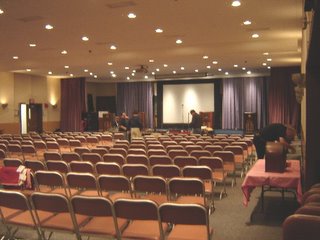 Thursday night, October 27: Sarnoff Corporation auditorium as the NJARC begins setting up.
Thursday night, October 27: Sarnoff Corporation auditorium as the NJARC begins setting up.
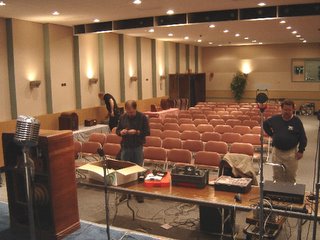
Al Klase and Dave Snellman build the radio station.
Photos below:
 Thursday night, October 27: Sarnoff Corporation auditorium as the NJARC begins setting up.
Thursday night, October 27: Sarnoff Corporation auditorium as the NJARC begins setting up.
Al Klase and Dave Snellman build the radio station.
Al Klase tests
the period mics.
the receivers.
The cast and crowd await the director.

And the show begins. . .
Subscribe to:
Posts (Atom)
